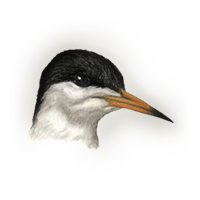|
Field
Guide IDs: BREEDING:
Freshwater and
saltwater marshes, marshy borders of ponds and
lakes. 1 brood. DISPLAYS:
? NEST:
Deeply hollowed,
well rounded, compactly woven platform; lined with
bits of reeds, grass. Also makes depression in mud
and sand or pats down grass and soil, lined with
shells, grass. Often on muskrat houses, Occ nests
of Western Grebe. EGGS:
Buff, marked with
dark brown, often enwreathed. 1.7" (43
mm). DIET:
Insects taken
flying over marshes. Also dead fish, live and dead
frogs. CONSERVATION:
Winters s to
Guatemala (w), Bahamas and Greater Antilles (e).
Often associates with wetlands affected by
agriculture but impact on terns unknown. NOTES:
Usu in loose
colony; often associates with Yellow-headed
Blackbird. Site tenacity weak. Larger clutches
typically result of 2 females. Usu large,
elaborate, well-built nests, similar to those of
Franklin's Gull. Vigorous nest defense. Nests occ
parasitized by American Coots and Red-necked
Grebes. Hostile to other birds, including
Franklin's Gull. Uncommon and
irregular forager at Lagunita. ESSAYS: Parent-Chick
Recognition;
Swimming;
Site
Tenacity;
Coloniality;
Brood
Parasitism. REFERENCES:
Bergman et al.,
1970; McNicholl, 1982; Salt and Willard,
1971. |
